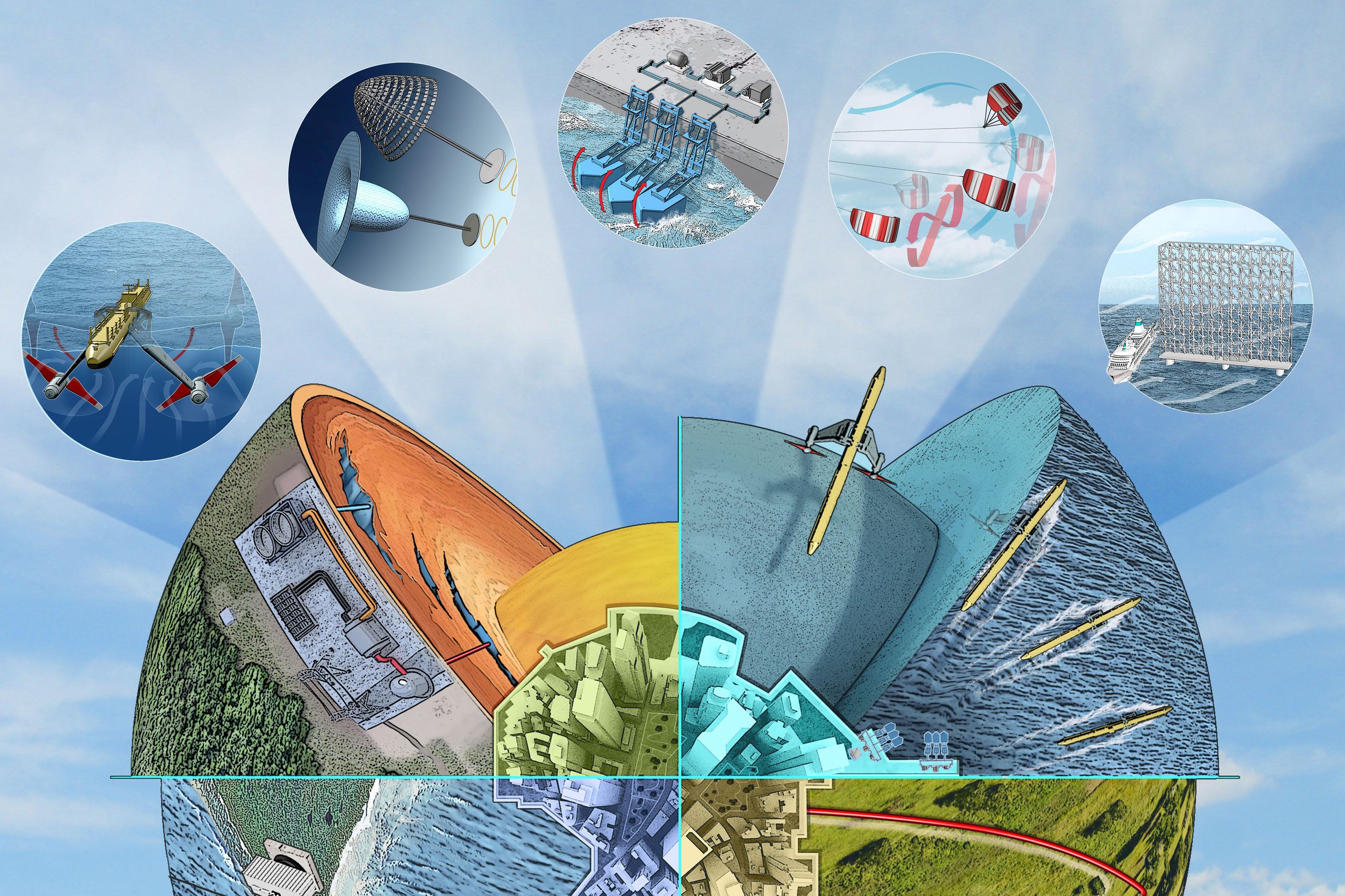The Next Bets for Renewable Energy
From underwater turbines to high-flying kites, companies look at innovative ways to harness traditional renewables.
With enormous kites that pull shipping vessels across oceans using wind power, floating devices attached to jetties that generate electricity from the motion of waves hitting the shore and other new technologies, companies are looking to diversify options for harnessing familiar sources of renewable energy in innovative ways. Many of these innovations aim to overcome cost and maintenance issues associated with existing technologies.
As world leaders endorse climate goals like reaching net-zero greenhouse-gas emissions within the next 30 years, these companies are pushing to move their projects from research and development to commercial phases. The net-zero objective—balancing emissions produced and emissions removed from the atmosphere—has spurred growth in the business of sustainable energy, which generates fewer emissions than fossil fuels. Some of these possibilities, like satellites that can wirelessly beam down solar energy from orbit, remain experimental, while others, like underwater turbines that harness tidal movements, have progressed from prototypes to commercial demonstrations. Here are some of the newest developments in generating power from the air, sun, water and Earth.
AIR
Stacked Turbines
Norwegian company Wind Catching Systems is developing a roughly 1,000-foot-tall structure consisting of 126 small turbines stacked and arranged together. The plan is for this “Wind Catching unit” to sit atop a floating platform anchored to the ocean floor about 50 miles offshore. The company says the unit will be able to turn 360 degrees to capture wind from any direction and generate electricity sent via underwater transmission lines back to shore.
The unit can produce up to five times more energy using one-fifth the space of typical offshore wind farms, says CEO and co-founder Ole Heggheim. The company expects to start construction on its first commercial prototype in the North Sea in 2023 and plans to market these wind catchers in the U.K.
Kite Power
SkySails Group, a Germany-based power company, is developing kites that fly a quarter-mile off the ground to produce energy. As the kite rises, it unwinds a tether connected to a winch and generator, which convert the force on the tether into electricity.
“High-altitude wind is the largest untapped energy resource on Earth,” founder and managing director Stephan Wrage says. Its largest kites are nearly 1,940 square feet in size—generating about 200 kilowatts of power, and meant to replace diesel generators in remote, off-grid islands and villages. The company has installed several pilot kites at sites including the Indian Ocean island nation of Mauritius, with plans to connect them to the grid. Starting next year, the company plans to start shifting toward commercial rollout, and eventually hopes to increase its kite size and flying altitude.
A French company, Airseas, has developed an 1003sqm kite called Seawing that attaches to a ship’s bow with a cable and pulls the vessel along using wind power. The company’s aim is to help decarbonize the shipping industry, says CEO and co-founder Vincent Bernatets.
WATER
Turning Tides
When placed underwater, turbines can harness kinetic energy from the natural rise and fall of ocean tides to generate electricity. But turbines placed on the seafloor are expensive to build and maintain. So Scottish company Orbital Marine Power designed a floating tidal turbine named Orbital O2.
The 72-metre-long turbine is anchored offshore near Scotland’s Orkney Islands, where a subsea cable connects it to the local grid. It can power around 2,000 U.K. homes and offset more than 2,400 tons of carbon annually. The company is focused on developing sites around the U.K. coastline and Europe, CEO Andrew Scott says, with an aim to deploy flotillas of tidal turbines. Future turbines will be anchored between about a mile and 3 miles offshore.
Wave Energy
Eco Wave Power Ltd. is working on harnessing water power from the shore. The company has designed 10-foot-long floating devices attached to piers, jetties and existing marine structures. These floaters use the rising and falling movement of waves to generate electricity.
The technology requires less than two feet of water to produce energy, “so we can basically install everywhere and anywhere,” says CEO and co-founder Inna Braverman. If waves get too rough, the devices can lock in an upward position above the water line. The company opened a 100-kilowatt facility connected to the grid in Gibraltar in 2016 that will be refurbished and moved to Los Angeles within the next three months. It expects to connect another power station in Jaffa, Israel, to the local grid by midyear this year. Future projects include possible facilities in New Jersey, California and Portugal.
EARTH
Geothermal Energy
Heat left over from when Earth formed and from radioactive elements decaying inside the planet’s molten core permeates toward the crust, creating accessible wells of steam or hot water. Some geothermal power plants pipe that steam or water—between 300 and 700 degrees Fahrenheit—to the surface for use as direct heat. Other plants can also convert that heat into electricity. The hydrothermal resources are injected back into the ground after cooling.
More than 60 geothermal plants operate in the U.S. today, providing nearly 4 gigawatts of electricity, which can power more than one million homes. But the plants tend to be concentrated in areas like California and Nevada with geothermal hot spots like geysers or volcanoes, or where tectonic plates grind past each other and Earth’s heat can move more easily through the crust. The key to making geothermal competitive with other renewables, is “going into regions where nature hasn’t been so generous, and figuring out a way to engineer the system,” says Cornell University professor Jefferson Tester. He is chief scientist for a pilot project at Cornell that aims to directly heat the 30,000-person campus with geothermal resources by 2035.
One solution, Dr. Tester says, is injecting “hot, dry rock”—which lacks the naturally occurring hydrothermal resources needed to generate electricity—with high-pressure water from the surface. That process can crack the rock, allowing a power plant to then collect the injected water after it is heated. The U.S. bipartisan infrastructure bill passed last year devoted $84 million to innovations like this, known as enhanced geothermal systems. These systems may enable engineers to expand the geographic range of where geothermal plants can be built.
SUN
Space-Based Solar
The sun’s power can only intermittently be harnessed from the ground due to weather, changing seasons and nighttime hours. But some scientists and engineers say within the next decade solar energy could come consistently from much closer to the source—wirelessly beamed down as microwaves or laser beams from orbiting satellites to receiving stations on Earth connected to the electrical grid.
“The basics are to put a large, very large platform in space, harvest sunlight, where the sun shines, essentially 99.95% of the time, and send it to markets on the ground, where, on average, the sun is shining only about 15% of the time,” says former NASA scientist John Mankins, president of Mankins Space Technology, a company working on developing a 1.6-km wide solar power satellite prototype that will use microwave beaming.
Wirelessly transferring energy across distances using microwave transmission has already been tested: The U.S. Naval Research Laboratory sent 1.6 kilowatts over a distance of 0.6 mile last year. Engineers at the Japan Aerospace Agency have sent about the same amount of energy the length of a football field.
Other groups are also working on the experimental technology: The California Institute of Technology plans on testing prototypes, which can transfer solar power in space via a steerable microwave beam, by the end of 2022. Engineers in Japan, China, Australia and Russia have all either made strides or expressed interest in developing space-based solar power.
The U.K. has integrated space-based solar energy into the country’s plan to reach net-zero emissions. Its Space Energy Initiative is spearheading a plan to send a 500-megawatt prototype that uses microwave beaming into orbit within the next decade, and aims to connect a satellite four times more powerful to the grid by 2035.
 Copyright 2020, Dow Jones & Company, Inc. All Rights Reserved Worldwide. LEARN MORE
Copyright 2020, Dow Jones & Company, Inc. All Rights Reserved Worldwide. LEARN MORE
This stylish family home combines a classic palette and finishes with a flexible floorplan
Just 55 minutes from Sydney, make this your creative getaway located in the majestic Hawkesbury region.
The marketplace has spoken and, at least for now, it’s showing preference for hybrids and plug-in hybrids (PHEVs) over battery electrics. That makes Toyota’s foot dragging on EVs (and full speed ahead on hybrids) look fairly wise, though the timeline along a bumpy road still gets us to full electrification by 2035.
Italian supercar producer Lamborghini, in business since 1963, is also proceeding, incrementally, toward battery power. In an interview, Federico Foschini , Lamborghini’s chief global marketing and sales officer, talked about the new Urus SE plug-in hybrid the company showed at its lounge in New York on Monday.

Lamborghini
The Urus SE SUV will sell for US$258,000 in the U.S. (the company’s biggest market) when it goes on sale internationally in the first quarter of 2025, Foschini says.
“We’re using the contribution from the electric motor and battery to not only lower emissions but also to boost performance,” he says. “Next year, all three of our models [the others are the Revuelto, a PHEV from launch, and the continuation of the Huracán] will be available as PHEVs.”
The Euro-spec Urus SE will have a stated 37 miles of electric-only range, thanks to a 192-horsepower electric motor and a 25.9-kilowatt-hour battery, but that distance will probably be less in stricter U.S. federal testing. In electric mode, the SE can reach 81 miles per hour. With the 4-litre 620-horsepower twin-turbo V8 engine engaged, the picture is quite different. With 789 horsepower and 701 pound-feet of torque on tap, the SE—as big as it is—can reach 62 mph in 3.4 seconds and attain 193 mph. It’s marginally faster than the Urus S, but also slightly under the cutting-edge Urus Performante model. Lamborghini says the SE reduces emissions by 80% compared to a standard Urus.
Lamborghini’s Urus plans are a little complicated. The company’s order books are full through 2025, but after that it plans to ditch the S and Performante models and produce only the SE. That’s only for a year, however, because the all-electric Urus should arrive by 2029.

Lamborghini
Thanks to the electric motor, the Urus SE offers all-wheel drive. The motor is situated inside the eight-speed automatic transmission, and it acts as a booster for the V8 but it can also drive the wheels on its own. The electric torque-vectoring system distributes power to the wheels that need it for improved cornering. The Urus SE has six driving modes, with variations that give a total of 11 performance options. There are carbon ceramic brakes front and rear.
To distinguish it, the Urus SE gets a new “floating” hood design and a new grille, headlights with matrix LED technology and a new lighting signature, and a redesigned bumper. There are more than 100 bodywork styling options, and 47 interior color combinations, with four embroidery types. The rear liftgate has also been restyled, with lights that connect the tail light clusters. The rear diffuser was redesigned to give 35% more downforce (compared to the Urus S) and keep the car on the road.
The Urus represents about 60% of U.S. Lamborghini sales, Foschini says, and in the early years 80% of buyers were new to the brand. Now it’s down to 70%because, as Foschini says, some happy Urus owners have upgraded to the Performante model. Lamborghini sold 3,000 cars last year in the U.S., where it has 44 dealers. Global sales were 10,112, the first time the marque went into five figures.
The average Urus buyer is 45 years old, though it’s 10 years younger in China and 10 years older in Japan. Only 10% are women, though that percentage is increasing.
“The customer base is widening, thanks to the broad appeal of the Urus—it’s a very usable car,” Foschini says. “The new buyers are successful in business, appreciate the technology, the performance, the unconventional design, and the fun-to-drive nature of the Urus.”
Maserati has two SUVs in its lineup, the Levante and the smaller Grecale. But Foschini says Lamborghini has no such plans. “A smaller SUV is not consistent with the positioning of our brand,” he says. “It’s not what we need in our portfolio now.”
It’s unclear exactly when Lamborghini will become an all-battery-electric brand. Foschini says that the Italian automaker is working with Volkswagen Group partner Porsche on e-fuel, synthetic and renewably made gasoline that could presumably extend the brand’s internal-combustion identity. But now, e-fuel is very expensive to make as it relies on wind power and captured carbon dioxide.
During Monterey Car Week in 2023, Lamborghini showed the Lanzador , a 2+2 electric concept car with high ground clearance that is headed for production. “This is the right electric vehicle for us,” Foschini says. “And the production version will look better than the concept.” The Lanzador, Lamborghini’s fourth model, should arrive in 2028.
Just 55 minutes from Sydney, make this your creative getaway located in the majestic Hawkesbury region.
Consumers are going to gravitate toward applications powered by the buzzy new technology, analyst Michael Wolf predicts























